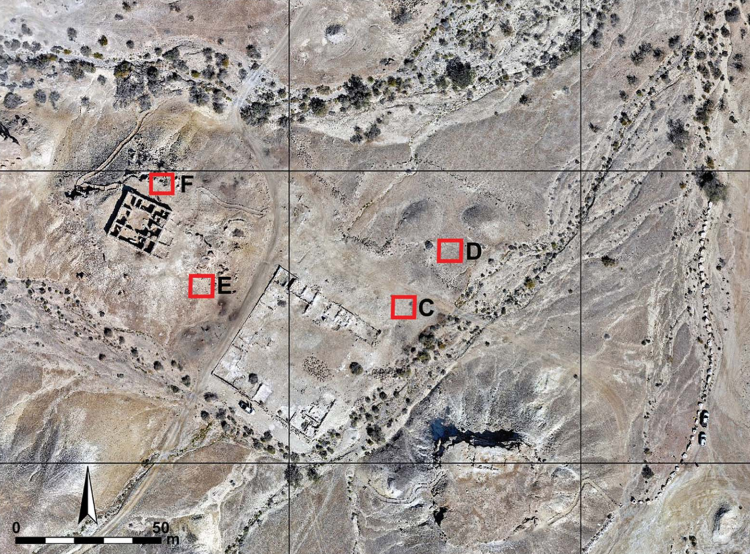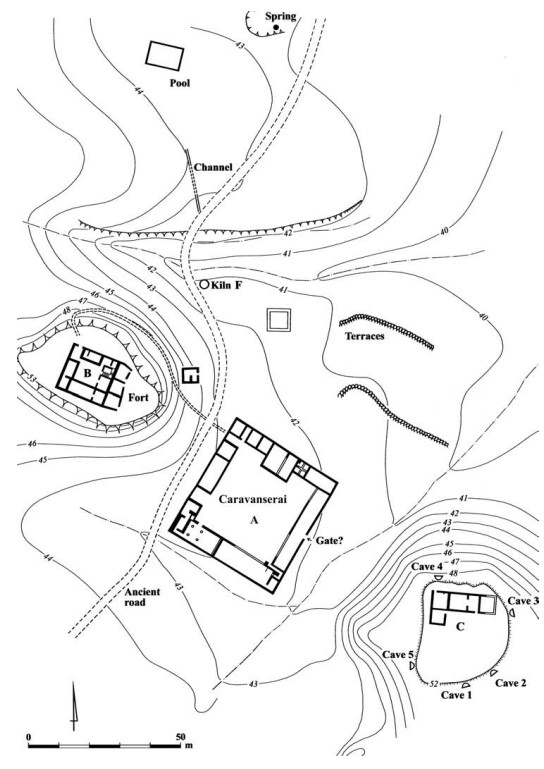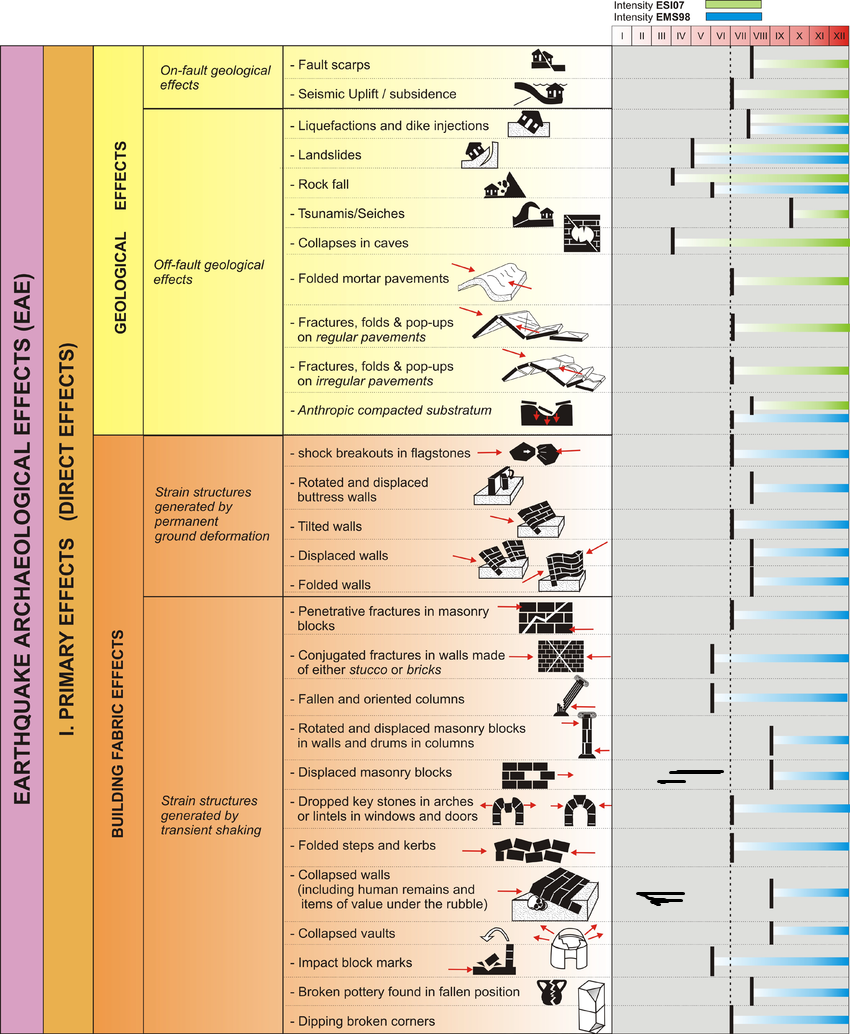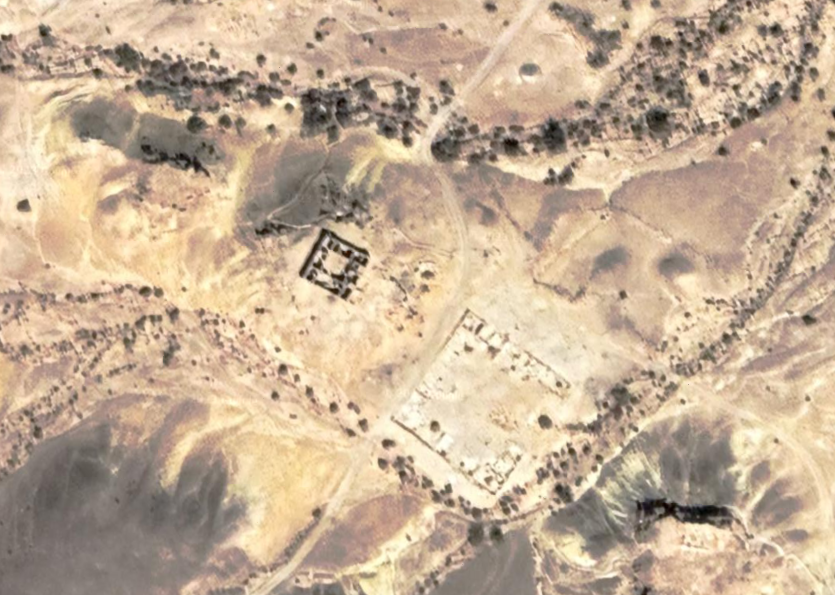Moje Awad
 Fig 3
Fig 3Aerial view of the Hellenistic Nabataean fort (Area B) at Moyat ‘Awad located in the western Arabah. (Courtesy of the Israel Antiquities Authority.)
Erickson-Gini and Israel (2013)
| Transliterated Name | Source | Name |
|---|---|---|
| Moje Awad | ||
| Moyat ‘Awad | Arabic | |
| Orhan-Mor | Hebrew? | |
| Moa | incorrect identification |
Moje Awad, located ~40 km. northwest of Petra, was founded by the Nabateans in the 2nd-3rd centuries BCE (Cohen, 1982) as the first station in the western Araba outside of Petra (Erickson-Gini and Israel, 2013). The site continued to exist into the 3rd century CE and was abandoned sometime after 222 CE (Erickson-Gini and Israel, 2013). Cohen identified the site as Moa on the Madaba map but this identification was probably incorrect because Moje Awad had been abandoned by the time the Madaba Map was produced and a proposal by Alt (1935) that Moa was Bir Madhkur appears to be vindicated (Erickson-Gini and Israel, 2013). Erickson-Gini and Israel (2013) listed structures in Moje Awad as follows:
- a Hellenistic Nabataean fort (Area B)
- a Nabataean caravanserai of the Roman period (Area A)
- cave dwellings and industrial structures (Area C)
- a kiln (Area F)
- agricultural terraces, and a water reservoir
Cohen (1982) excavated the site in 1981. Moje Awad produced a rich set of preserved artifactual remains which allowed for a confident dating of the three building phases encountered in most of the rooms by Cohen (1982). Erickson-Gini and Israel (2013) re-examined Cohen's excavation, added additional chronological information, and found archaeoseismic evidence for an early 2nd century CE earthquake.
Mo'a (Khirbet Moyat 'Awad), a site located near Nahal 'Omer in the central Arabah (map reference 1624.9947) was identified in 1934 as the remains of a Roman fort by F. Frank, who drew a plan of the central structure (44 by 41 m). Only two or three courses of stones survive. West of this structure Frank noticed the remains of an older fort, and to the east yet another small structure. A. Alt, relying on Frank's discoveries, identified the site with Asuada, a fort mention in the Notitia Dignitatum (XXXIV, 32). Glueck collected Nabatean sherds on the surface. Later, G. E. Kirk stated that the site dated, at the latest, to the second century CE. F. M. Abel and M. Avi-Yonah were inclined to identify Khirbet Moyat 'Awad with Mo'a, which appears on the Medeba map; not all scholars agree. The site has been surveyed by A. Negev, B. Rothenberg, M. Gichon, Z. Ilan, and others. In 1980, a survey was conducted by a team headed by D. Nahlieli, as part of the Negev Emergency Survey. R. Cohen excavated the site from 1981 to 1984, on behalf of the Israel Department of Antiquities and Museums. The excavations, conducted in six areas (A-F), exposed the site's six main structures.
- Fig. 1 - Major Roman trade
routes in the vicinity of Moje Awad from Bar-Oz et al (2022)

 Figure 1
Figure 1
Major Roman trade routes in the Negev and photographs of excavated sites. The red circles indicate the location of excavated dumps (photographs by R. Galili).
Bar-Oz et al (2022)
- Fig. 3 - Aerial view of Moje Awad
from Bar-Oz et al (2022)

 Figure 3
Figure 3
Aerial view of the Nabataean–Roman (first to third century AD) site of Orhan-Mor and the location of excavations (photograph by R. Galili).
Bar-Oz et al (2022) - Fig. 3 - Aerial view of the
Hellenistic Nabataean fort from Erickson-Gini and Israel (2013)

 Fig 3
Fig 3
Aerial view of the Hellenistic Nabataean fort (Area B) at Moyat ‘Awad located in the western Arabah. (Courtesy of the Israel Antiquities Authority.)
Erickson-Gini and Israel (2013) - Moje Awad in Google Earth
- Moje Awad on govmap.gov.il
- Fig. 24 - Plan of the site
from Erickson-Gini and Israel (2013)

 Figure 24
Figure 24
Plan of the site of Moyat ‘Awad in the western Arabah. (Courtesy of the Israel Antiquities Authority.)
Erickson-Gini and Israel (2013)
- Fig. 24 - Plan of the site
from Erickson-Gini and Israel (2013)

 Figure 24
Figure 24
Plan of the site of Moyat ‘Awad in the western Arabah. (Courtesy of the Israel Antiquities Authority.)
Erickson-Gini and Israel (2013)
| Phase | Period | Approximate Dates | Comments |
|---|---|---|---|
| Initial | Hellenistic | 3rd - 2nd centuries BCE |
Erickson-Gini and Israel (2013)Coins and artifacts discovered over the bedrock inside the fort point to its construction and occupation sometime in the third century BCE. The caravanserai was probably built towards the end of the reign of Aretas IV (9 BCE – 40 CE). Cohen (1982) The earliest contained pottery, including Hellenistic oil lamps and juglets belonging to the 2nd-3rd centuries B.C.E. and coins from the reign of Ptolemy III |
| Middle | Early Roman | 2nd century BCE - 1st century CE |
Erickson-Gini and Israel (2013)In the Early Roman period, the fort continued to be occupied even after the construction of a 40 x 40 m caravanserai in Area A Cohen (1982) The plentiful pottery from the middle phase can be dated to the end of the 1st century c.E. and features painted Nabatean bowls, oil lamps, jugs, juglets, cooking pots, and storage jars; there were also Nabatean coins from the reigns of Aretas II (103 BCE – 96 BCE), Aretas IV (9 BCE – 40 CE), and Rabbel II (70 – 106 CE). |
| Final | Late Roman | 2nd - 3rd centuries CE |
Erickson-Gini and Israel (2013)the great majority of the finds from inside the fort and its ancillary rooms date to the latest phase of its occupation in the Late Roman, post-annexation phase, the latest coins of which date to the reign of Elagabalus (219–222 CE) Coins of Emperor Elagabalus, uncovered in the fort, show that it was abandoned sometime after 222 CE Cohen (1982) The many ceramic vessels of the final phase included bowls, oil lamps, and flasks, of 2nd-3rd century c.E. vintage. There were also coins of the Roman emperors Trajan (98 – 117 CE), Commodus (161 – 192 CE), and Caracalla (188 – 217 CE) |
- Fig. 24 - Plan of the site from
Erickson-Gini and Israel (2013)

 Figure 24
Figure 24
Plan of the site of Moyat ‘Awad in the western Arabah. (Courtesy of the Israel Antiquities Authority.)
Erickson-Gini and Israel (2013)
Erickson-Gini and Israel (2013) discussed the early 2nd century earthquake at Moje Awad as follows:
The Early Roman phase of occupation in the site ended with extensive damage caused by an earthquake that took place shortly before the Roman annexation of the region in 106 CE ( Korzhenkov and Erickson-Gini, 2003). The building in Area C and the kiln works were destroyed, and the cave dwellings were apparently abandoned as well. Reconstruction was required in parts of the fort. At this time, deposition from its floors was removed and thrown outside of the fort and a new bath as well as heating were constructed in its interior. Along its eastern exterior and lower slope, rooms were added.No photos of destruction were supplied and it is unclear if earthquake destruction was inferred from rebuilding evidence or if actual damaged structures were observed. Likewise, it is not clear how Erickson-Gini and Israel (2013) dated this earthquake to shortly before Roman annexation in 106 CE. If the pre 106 CE date is based on rebuilding evidence, it would seem that the earthquake is dated no more precisely than early second century CE.
| Effect(s) | Location | Image(s) | Description |
|---|---|---|---|
| Collapsed Walls | The building in Area C and the kiln works
 Figure 24
Figure 24Plan of the site of Moyat ‘Awad in the western Arabah. (Courtesy of the Israel Antiquities Authority.) Erickson-Gini and Israel (2013) |
|
|
| Collapsed caves ? | cave dwellings
 Figure 24
Figure 24Plan of the site of Moyat ‘Awad in the western Arabah. (Courtesy of the Israel Antiquities Authority.) Erickson-Gini and Israel (2013) |
|
-
Earthquake Archeological Effects chart
of Rodríguez-Pascua et al (2013: 221-224)

 Earthquake Archeological Effects (EAE)
Earthquake Archeological Effects (EAE)
Rodríguez-Pascua et al (2013: 221-224)
| Effect(s) | Location | Image(s) | Description | Intensity |
|---|---|---|---|---|
| Collapsed Walls | The building in Area C and the kiln works
 Figure 24
Figure 24Plan of the site of Moyat ‘Awad in the western Arabah. (Courtesy of the Israel Antiquities Authority.) Erickson-Gini and Israel (2013) |
|
VIII+ | |
| Collapsed caves ? | cave dwellings
 Figure 24
Figure 24Plan of the site of Moyat ‘Awad in the western Arabah. (Courtesy of the Israel Antiquities Authority.) Erickson-Gini and Israel (2013) |
|
III+? |
Alt, A. (1935).
"Aus der ʿAraba. II. Römische Kastelle und Straßen." Zeitschrift des Deutschen Palästina-Vereins (1878-1945)(H. 1/2): 1-78.
Bar-Oz, G., Galili, Roy, Fuks, Daniel, Erickson-Gini, Tali, Tepper, Yotam, Shamir, Nofar, Avni, Gideon (2022).
"Caravanserai middens on desert roads: a new perspective on the Nabataean–Roman trade network across the Negev." Antiquity 96(387): 592-610.
Cohen, R. (1982). "New Light on the Date of the Petra-Gaza Road." The Biblical Archaeologist 45(4): 240-247.
Erickson-Gini and Israel (2013). "Excavating the Nabataean Incense Road." Journal of Eastern Mediterranean Archaeology & Heritage Studies 1(1): 24-53.
Abel, GP2, 181-182
F. Frank, ZDPV57 (1934), 270-276
G. E. Kirk, PEQ 70 (1938), 231-234
A.
Negev, ibid. 88 (1966), 89-98
M. Gichon, Roman Frontier Studies 12 (1979), 843-864
R. Cohen, IEJ 32
(1982), 164-165
id., BA 45 (1982), 240-247.

